Clouds and climate change - discussions and research
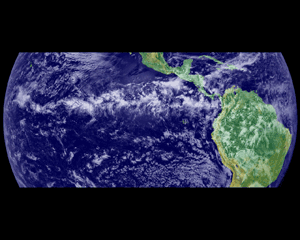
Introduction
The news story suggests lots of interesting topics for discussion and research.
Take a look at those we've picked out from the text. Compare ours with those you found using the methods in Getting the topics.
In groups discuss the differences. This isn't about right or wrong. Your choice is as good as ours as long as you can explain and defend it.
Now have a go at some of the topics - ours or yours.
Selected topics
As the greenhouse gases warm the Earth
The Earth won't warm as quickly.
Round and round in a positive feedback that we don't want at all.
That warming oceans produce less clouds above them
Only the Hadley Centre model by the UK Met Office was able to reproduce the observations.
This can help improve the simulation of clouds in climate models, which will lead to more accurate projections of future climate changes.
Want more?
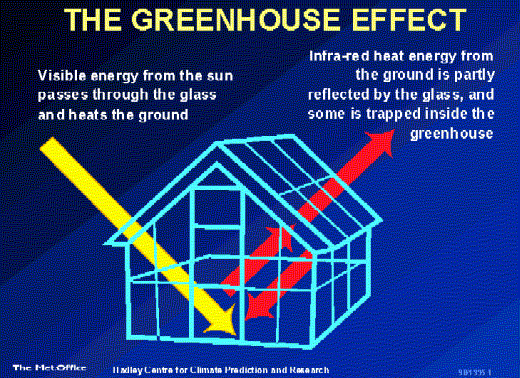
As greenhouse gases warm the Earth
Let's take a look how energy from the sun warms the Earth - and what it's got to do with greenhouses.
It's all about the greenhouse effect, right?
Well yes. Just one thing though. The greenhouse effect hasn't a lot to do with greenhouses.
Scientists used to think it did. That's how the effect got its name. But we now know that the picture on the left doesn't tell the true story of how a greenhouse works.
All that visible light passing through and infra-red getting trapped is the greenhouse effect all right. But it's not what makes a greenhouse work. So bit of a bad name. But we're stuck with it now.
So here's your first question. How does a greenhouse work, if it's not by the greenhouse effect?
Why is it warmer inside a greenhouse than outside it?
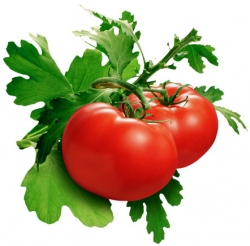
Make a start by searching on "how a greenhouse works". The HowStuffWorks site is good, but you can find others that tell the same science story.
Now let's take a look at the greenhouse effect. This is what happens in the atmosphere of planets, rather than in greenhouses. To see what it's about go to the Begbroke Science Park site and to its animated slide-show "The Basics of Climate Prediction".
Hit the Start button. There's a lot of good stuff there, which we'll come back to.
Right now we'd like you to hit Next and take the wee quiz. How did you get on?
If you did well give yourself a pat on the back. If you didn't, don't worry too much. Just go back when you've done a few of the topics on this page and it'll be a breeze.
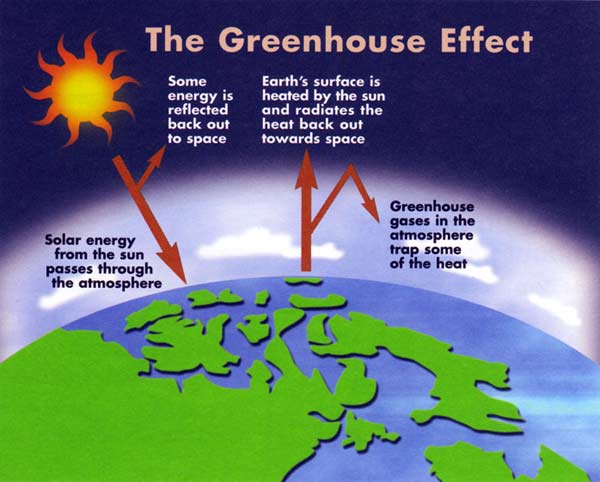
The Earth won't warm as quickly
From here on we're going to be looking at the greenhouse effect rather than greenhouses. So if you're more interested in growing tomatoes than saving the planet, you should leave now.
But take a look first at how you can grow them better using computers.
So for the non-tomato-growers here we go with the greenhouse effect.
Go back to the "The Basics of Climate Prediction". This time hit Start then hit Next five times.
You should see a picture of a tap and a bucket.
Read the words, play around with the tap and watch what happens to the level of water in the bucket. Take a look too at how fast it flows out.
Now hit Next again and have a read at what taps and buckets have to do with global warming. Play with the model again. Focus first on what's happening when the level in the bucket is steady, rather than changing. Take your time. There's a lot of science in this model and you won't get what it's all about right away.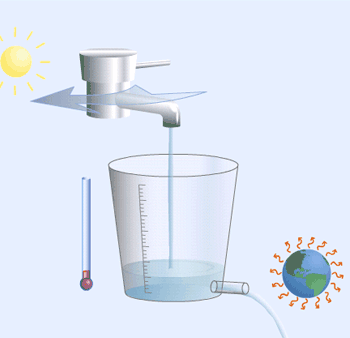
Now working in your groups try to figure out how we can connect this model with clouds.
Start from what we're told:
"The energy from the --- is the water from the tap."
"The energy lost by the ----- is the water flowing out of the bucket."
"The temperature of the Earth is the ------ of water in the bucket."
Now what about the greenhouse effect? Well greenhouse gases in the air - such as the carbon dioxide we prodce in cars, planes and factories - stop some heat energy from Earth from being lost into space.
So here's the question for your groups: What's missing from the tap and bucket model of the climate that would let us show this?
If you had a real tap and bucket in front of you - and a plumber's shop right next door - what would you fit to the bucket to allow you to model the greenhouse effect?
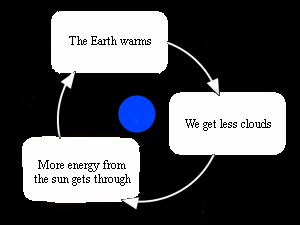
... round and round in a positive feedback that we don't want at all.
Positive feedbacks are everywhere. And they're not hard to understand.
Find as many examples as you can from science or everyday life.
What do they all have in common?
Pick one example of positive feedback that appeals to you and explain it to your colleagues, using any medium you fancy.
In putting this together do what journalists do - give nice examples, tell a story, look at detail not general stuff, bring people into the story.
Now back to climate change. Find two examples, other than the one in this latest news story, of positive feedback in climate change. Here's one that might interest you - global warming caused by New Zealand sheep.
Are they serious, do you think?
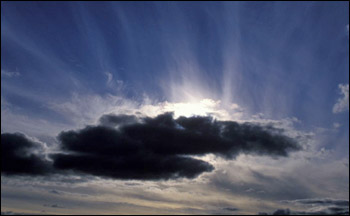
That warming oceans produce less clouds above them
Now we're getting to the meat of this latest research. It's quite complicated in places. But like most science, plenty of it is straightforward, if you take your time and keep thinking.
We've looked at greenhouses, the greenhouse effect and positive feedback. We now have two questions to think about:
1) Do clouds help make the Earth warmer or cooler?
2) Does a warming world make more clouds or less of them?
Click on the image to the right to see what NASA says about the effect of clouds up there on temperature down here: Here's an extract:
"Possibly no part of the climate system is more unpredictable than the interaction between atmospheric water and radiation emitted by the Sun and the Earth. At any given time, a small sea of water floats above our heads in the form of clouds, ice, and water vapour.
The form and position the water takes in the sky changes the way it interacts with solar and thermal radiation. Clouds, especially low-lying, thick clouds, reflect an enormous amount of sunlight back into space and keep it from overheating the Earth.
High-flying, wispy clouds and water vapor absorb greater amounts of outgoing thermal (heat) radiation, which is generated by the surface of the Earth after it is warmed by the Sun. Along with greenhouse gases, such clouds and water vapour contribute to keeping the average temperature of the Earth's surface from dropping to Arctic levels year round."
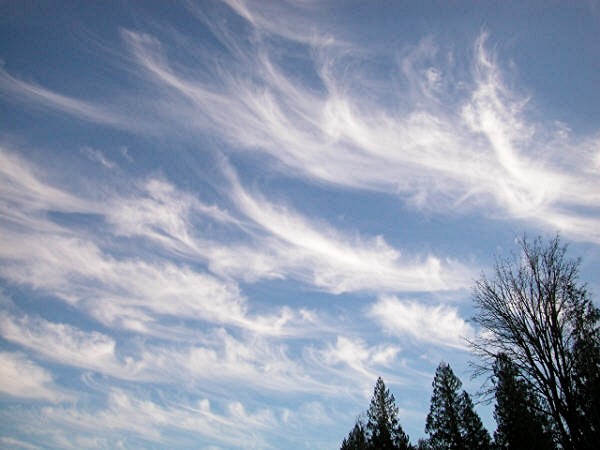
So what they're saying is that all clouds do two things that have opposite effects:
1) They reflect heat energy from the sun back into space (the albedo effect) and
2)They absorb heat energy heading out to space and keep it here on Earth (the greenhouse effect).
Clouds help keep Earth cool and they help keep Earth warm.
Which wins? Well that depends on the type of cloud. Have a read again at what NASA says in the three paragraphs above, mouseover the hard words, then complete these two sentences:
Low clouds are like the reflective coatings people put on roofs to keep houses cool in summer. They block more heat from the sun above than the Earth below. So they make Earth ------.
High wispy clouds are like an overcoat that keeps you warm in winter. They block more heat from the Earth below than the sun above. So they make the Earth ------.
All this is science that we know.
What we don't know is the answer to Question 2: Does a warming world make more clouds or less of them?
And we can now add an additional question: Which kind of cloud does it make more or less of?
The research on the news page was aimed at answering these questions. Take a look at the news story again and tell me this: What answer to Question 2 does the new research give?
Science is a communal activity. So the first thing that happens when new research is published is that the other scientists in the same field study it and criticise it. They look for mistakes. They try to repeat the calculations or experiments themselves.
Over the next few days keep an eye out for comment and criticism of this latest research, in the newspapers and on the blogs.
Then try to answer the following questions:
Does it look as if Clements and her colleagues got it right? Do we know more about cliimate change now than we did? What more do we know?
Only the Hadley Centre model by the UK Met Office was able to reproduce the observations.
Models in science
In these last two topics we'll take a look at how models help us understand climate change.
We'll also look briefly at some of the arguments of the climate change sceptics and deniers. These are usually aimed at the models and the uncertainties they contain.
"When did we start doing science with models - what's wrong with experiments?" was one blog post I read recently on a climate change website.
Well we started doing science with models when we started doing science. So around 500 years ago is the answer. And doing experiments without theories and models to explain the results and point the way to more experiments is collecting data not doing science.
Have a read at what the University of Texas at Austin has to say:
"The model is the most basic element of the scientific method. Everything done in science is done with models."
"Hypotheses and theories are merely particular kinds of models."
"The periodic table of the elements is a model chemists use for predicting properties of the elements. Physicists use Newton's laws to predict how objects will interact, such as planets and spaceships. In geology, the continental drift model predicts the past positions of continents."
"Models are used at every turn in a scientific study. Samples are models. Ideas are models. Methods are models. Every attempt at a scientific study involves countless models, many of them small and of interest only to a small group of other scientists. The primary activity of the hundreds of thousands of scientists is to produce new models."
[More words: tentative, investigating, observation, experiment, theory]
Models in climate change
A number of models have been developed by scientists around the world to help us understand and predict what the climate has done in the past and will do in the future. These are being tested all the time against observations, and improved as our understanding of the physics of the atmosphere grows.
The Intergovernmental Panel on Climate Change is an organisation set up by countries around the world to study all the information on climate change and pull it together. Take a look at their Climate Models and their Evaluation.
Do a search on the word 'clouds' and read some of the sentences that contain this word. This will give you a flavour of the current state of clouds and climate models.
In groups put together one paragraph that captures what this report says about clouds and climate models.
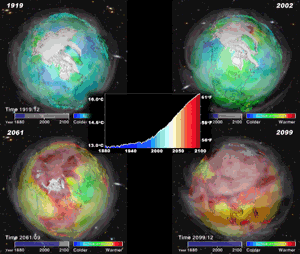
This can improve the simulation of clouds in climate models, which will lead to more accurate projections of future climate changes.
The effect of clouds is one of the main points of attack of the climate change sceptics and deniers. They claim that the scientists are wrong, the models are inadequate and we don't need to worry about climate change.
Working in groups investigate the statement. "Clouds have a huge effect on the climate. The climate models are hopeless when it comes to clouds. So we don't need to worry about global warming."
Do a web search on clouds and climate. You might like to take a look at some of these sites:
Climate change: A guide for the perplexed
How to talk to a climate sceptic
Get a little help from your teacher to set up a classroom debate using a cooperative learning method known as Academic Controversy - there's another outline of this approach here
After you've done this, get both sides of the debate to think about how easy or hard it was to make sense of their side of the argument. Share your thoughts and feelings with the class.
Want more?
1. It's easy to see how warmer oceans could give more clouds, since there will be more evaporation of water into the atmosphere. But how could they give less?
Here's the way a New Scientist article explains it:
"A first guess would suggest that extra evaporation and water vapour in the atmosphere will make more clouds. But it may not be so simple. Higher evaporation rates in the heat of a greenhouse day may "burn off" clouds without them ever producing rain. Equally, clouds may "rain out" more quickly, leaving clearer skies rather than cloudier ones. The fear is that clearer skies will amplify, rather than damp down global warming.
And there is growing evidence that this clear-skies effect could already be under way. One of the foremost experts on clouds and climate, Bruce Wielicki of NASA's Langley Research Center, has found that there are fewer clouds these days in the tropics. Since the mid-1980s, he says, the rising and descending motions of air that cover the entire tropics, for example in the Hadley circulation cells (see Diagram), appeared to increase in strength. The result was faster formation of storm clouds in areas where the air rises - what meteorologists call the inter-tropical convergence zone - but with the clouds raining out more quickly, which left the rest of the tropics drier and less cloudy."
2. Here's the paper itself.
4 Climate change collection of classroom resources
6 NASA climate modelling in the classroom
7. The stories clouds tell from UCAR
8. Vega videos
9. NASA videos
10. Del Genioresearch
11. RealClimate start here
12. Global warming from NASA
14. Expert reaction to publication of UK Climate Impacts Programme (UKCP09)
16. BBC
17. UKCP09
18. Hadley Centre
19. Stern review
20. How to read a scientific paper
22. Iris effect Lindzen Chou et al
25. Ceres
